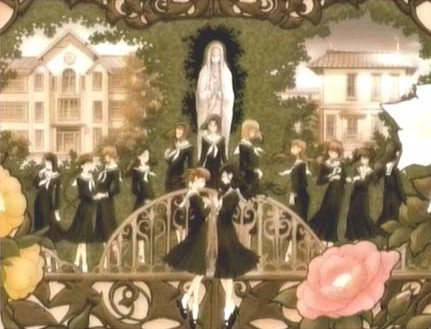
Maria-sama ga Miteru (literally Mary is Watching) is set at Lillian Jogakuen, an all-girls K-12 school with rich tradition and even richer students. The school has a "soeur system" of pairing upperclassmen with underclassmen for guidance and companionship. The tie between soeurs is an ambiguous kind of love somewhere between filial, friendly, and romantic, chaste but passionate.
At the center of all this is the Yamayurikai (Mountain Lily Council), a kind of student council made up of only members of the very most upper-echelon of Lillian Jogakuen's students. The Yamayurikai is split up into three groups: Rosa Chinensis, Rosa Foetida, and Rosa Gigantea, each of which has three levels: Rosa, en bouton (in bud) and en bouton petite soeur. These girls are idolized by the rest of the students and it hardly needs mentioning that there isn't much the underclassmen wouldn't do to be chosen as a petite soeur by one of them. Enter Yumi Fukuzawa, this series' particular incarnation of your friendly everyday shy schoolgirl. I don't think it's much of a spoiler to say that, after various wacky hijinks, she gets chosen as the petite soeur of Sachiko Ogasawara, the most idolized of all the en boutons.

It's tempting to compare this series to the Oniisama e because of their similar plots, but the atmosphere of the two is so vastly different. While Oniisama e is the epitome of melodrama, Maria-sama ga miteru seems almost to be anti-melodrama - if there is ever a conflict, it only lasts for an episode and a half or so, after which the girls return to their state of almost aggressive calm. Everything is peaceful and gentle and absolutely mild.
A more apt comparison would be to the "Class S" genre of pre-war Japan: stories of romantic friendships between upperclassmen and underclassmen at all-girls schools. Japanese reviewers often describe Maria-sama ga miteru as a rebirth of the once-beloved genre, and its popularity launched a legion of knockoffs of various qualities (which will probably be reviewed in this blog sooner of later). Whether Yoshiya Nobuko would be proud is debatable, but for better or for worse Maria-sama ga miteru and its copycats have made the schoolgirl love she championed live on.
